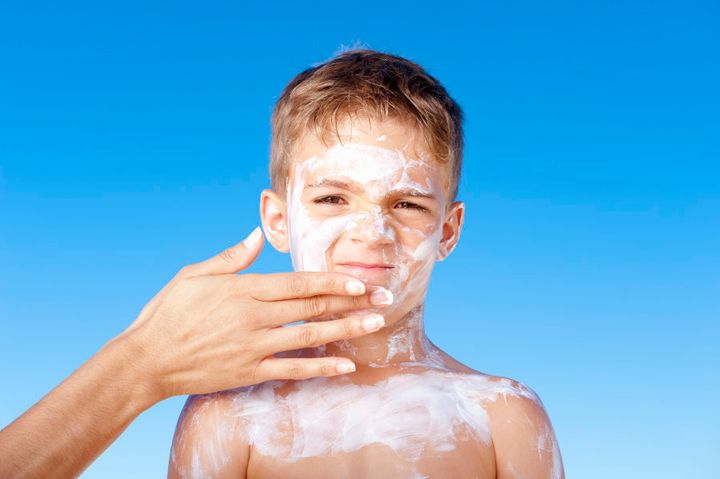Sunscreen is a non-negotiable of summer in Australia. But lately there's been a bit of chatter about potentially harmful effects of using sunscreen.
One Queensland mother, Jessie Swan, has posted on Facebook about the bad reaction her three-month-old son had to a Peppa Pig Cancer Council kid's sunscreen. Since the post, several parents have come forward with similar stories after using sunscreen. It has been shared over 8000 times and attracted more than 3000 comments.
However, while such stories are distressing, this doesn't mean that we should give up on sunscreen altogether.
The Cancer Council Australia responded to the post, agreeing that Jessie's experience was "upsetting". However, the product was "approved by the TGA" and is also "dermatologically tested to ensure it passes the Repeat Insult Patch Test (RIPT), a recognised formal skin sensitivity test."
The Cancer Council recommends doing a patch test to see if there are any negative reactions before applying the sunscreen to your whole body.
Last year, celebrity chef Pete Evans caused a stir with his scathing view of people who apply "normal chemical sunscreen then lay out in the sun for hours on end and think that they are safe because they have covered themselves in poisonous chemicals."
Australia is leading the world in melanomas but we are seriously lagging behind in terms of sunscreen.
So where does that leave us? Here are some of the facts we know about sunscreen:
How much sunscreen should I use?
Imagine a golf ball in your hand, then fill it up with that amount of sunscreen. Turns out that most of us are using around half the sunscreen we are meant to be using. About 30-40 ml of sunscreen is needed for the average adult in order to reach the recommended 2 milligrams per square centimetre.
As the Cancer Council suggests, do a test patch when you use a new product to make sure there are no adverse reactions on your skin. And don't forget to reapply, especially after swimming or sweating.
How sunscreen is tested?
Because of the harsh UV rays in Australia, the Therapeutic Goods Administration (TGA) has very strict conditions before sunscreens are released into the Australian market. The TGA is responsible for testing all active and non-active ingredients in sunscreen as well as claims regarding SPF, water resistance and sweat resistance.
"Sunscreens that are labelled 'Broad Spectrum' have been tested to provide protection from UVA radiation as well as UVB radiation," Tracey Beeby from Australian skincare brand Ultraceuticals previously told The Huffington Post Australia.
"So when purchasing an SPF it is essential that it is labelled 'Broad Spectrum' which means it's using both UVA and UVB screening ingredients."
Chemical verses physical sunscreen
There are two basic types of sunscreens: chemical and physical. The chemical ingredients -- mainly Octylcrylen, Avobenzone and Octinoxate -- absorb the UV rays, transforming the electromagnetic radiation effect on the skin. Physical ingredients -- zinc and titanium oxide -- create a barrier on the skin to reflect the UV rays.
So which is best?
Both will be effective as long as they are appropriately applied. Chemical sunscreen tends to be the most common type and offer broader protection against UVA and UVB rays. The physical sunscreen is known to create that 'ghosting' effect, however with better technology this is being reduced. Chemical sunscreen tends to cause more negative reactions and you will find that kids' sunscreens have more physical blocking agents in them for this reason. Either way, there is a sunscreen that will suit your skin.
You can read more about the differences between chemical and physical sunscreen here.
You need to wear sunscreen on a cloudy day
There are two types of UV rays -- UVA and UVB. The UVB radiation feels hot and burning on your skin, however the UVA rays also penetrate the skin causing damage, even though we can't feel them. This is why you still need to apply sunscreen while driving in the car, working near a window or going outside on a cloudy day.

Sunscreen has a use-by date
Did you know there is a use-by date on your sunscreen? It's there for a reason. It's an indication of how long the product will be effective so check the date and replace expired sunscreen.
Store sunscreen below 30 degrees
Storing sunscreen above 30 degrees for prolonged periods of time can start to affect it's SPF. So if you leave your sunscreen in a hot car, think again before you apply it. Instead, keep your sunscreen in the esky when going out or in a cool cupboard at home.
Sunscreens in cosmetics are not enough
The SPF of makeup or moisturiser is generally not higher than SPF 15 and is not broad spectrum. Professor Pascale Guitera, Dermatologist Associate for the Melanoma Institute of Australia previously told Huffpost Australia that it's best to apply sunscreen under your makeup.
ALSO ON HUFFPOST AUSTRALIA